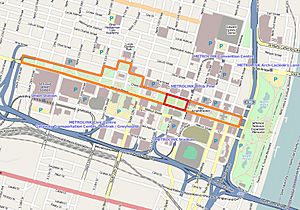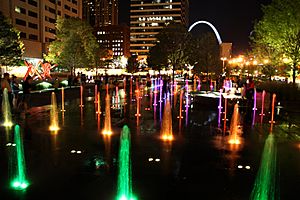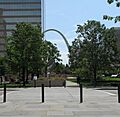Citygarden facts for kids
Quick facts for kids Citygarden |
|
|---|---|
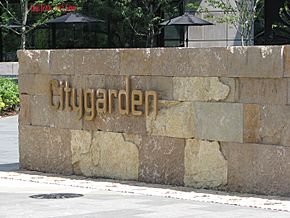
The restaurant building is visible behind this sign for Citygarden.
|
|
| Type | Urban park and sculpture garden |
| Location | Between Eighth, Tenth, Chestnut, and Market streets, St. Louis, Missouri, United States |
| Area | 2.9 acres (1.2 ha) |
| Created | July 1, 2009 |
| Operated by | Gateway Foundation |
| Visitors | 1,000,000+ (estimated) |
| Status | Open year round |
Citygarden is a special park and sculpture garden located in St. Louis, Missouri. It's owned by the City of St. Louis, but a group called the Gateway Foundation takes care of it. You can find Citygarden in the city's "Gateway Mall" area, between Eighth, Tenth, Market, and Chestnut streets.
Before it became this amazing garden, the area was just two empty blocks of grass. Citygarden officially opened its doors on July 1, 2009.
This park is about 2.9 acres (1.2 ha) big, which is like two city blocks! It cost about US$30 million to build. The Gateway Foundation, a group that helps create public art, paid for all the design and building. Even though the city owns the land, the foundation owns all the cool statues and pays for most of the park's upkeep, like security.
The best part? It's completely free to visit Citygarden! It's also close to famous spots like the Gateway Arch and Busch Stadium. The park is open all year round and is easy for everyone to get around, including people with disabilities.
Contents
How Citygarden Started
Public art has been a part of the Gateway Mall for a long time. Back in 1940, a large sculpture by Carl Milles was placed near St. Louis Union Station. Later, in 1982, a sculpture called Twain by Richard Serra was put up nearby. This shows that the idea of art in public spaces was already important in St. Louis.
In the late 1990s, some St. Louis residents dreamed of a new downtown. Their plan included a sculpture garden exactly where Citygarden is now. This idea didn't happen right away. But in 2006, the City of St. Louis asked the Gateway Foundation to create a big plan for the entire Gateway Mall.
In early 2007, the foundation held a contest for park designs. A company called Nelson Byrd Woltz Landscape Architects won. The plan to build Citygarden was announced in June 2007. Construction started in April 2008. By Christmas 2009, over 250,000 people had visited Citygarden. Now, it's estimated that over a million people have enjoyed the park! Since Citygarden doesn't have gates, there's no exact visitor count.
When Citygarden opened, the Mayor of St. Louis Francis Slay was very excited. He said the garden would become one of St. Louis's best attractions. He praised how open and welcoming it was in the heart of downtown. The mayor even told workers to turn on the fountains and remove the construction fence. On opening day, many visitors came to see the new park.
A year later, on July 10, 2010, Citygarden celebrated its first anniversary. There was even a fun flamingo parade! This parade was meant to show the park's playful and unique spirit.
Why Citygarden is Important
Citygarden has made a big difference for downtown St. Louis. A city leader said it has encouraged many people to visit the area. It has also helped the local economy. The park's popularity has even sparked new interest in fixing up the rest of the Gateway Mall. Mayor Slay hopes Citygarden will inspire more amazing public spaces in the city.
Rocco Landesman, who used to lead the National Endowment for the Arts, has used Citygarden as a great example. He said that projects like this can help cities grow. He also noted that private groups and foundations are important for funding such projects. Citygarden's design and success even attracted Michael Van Valkenburgh, a famous landscape architect. He was chosen in 2010 to redesign the area around the Gateway Arch.
Amazing Sculptures
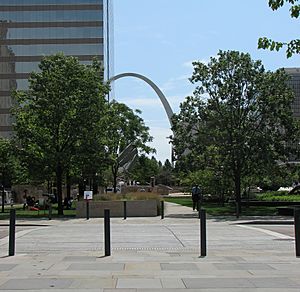
Citygarden is designed so that big artworks sit on wide lawns. Smaller, more private areas hold other pieces. The park is home to 24 sculptures by famous artists. Some of these artists include Fernand Léger, Keith Haring, Jim Dine, and Niki de Saint Phalle.
One statue by Igor Mitoraj is a large bronze head lying on its side. Other works by Julian Opie are digital screens showing people walking. What's cool is that visitors can touch the sculptures and even walk inside some of them! This means the art needs regular care, like re-waxing. The sculptures are made from different materials, including bronze, stainless steel, aluminum, fiberglass, and polyester. In 2011, a 9-foot (2.7 m) pink suit sculpture called Big Suit by Erwin Wurm was added.
The Gateway Foundation already owned two of the sculptures before the park was built. They bought the rest between 2006 and 2009. The cost of the art was not included in the $30 million park budget. Experts believe the collection is worth around $12 million or even more. Some people have said that 24 sculptures might be too many for the park's size.
Cool Sculptures to See
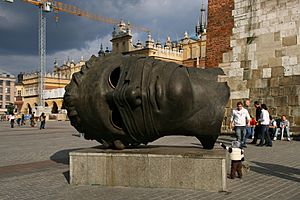
Here are a few of the interesting sculptures you can find in Citygarden:
- 2 Arcs x 4 and 230.5 Degree Arc x 5 (1999) are three steel sculptures by Bernar Venet. They are large steel beams bent into different arcs.
- Big White Gloves, Big Four Wheels (2009) is a statue of Pinocchio by Jim Dine.
- Eros Bendato ("Eros Bound"; 1999) is a large bronze head by Igor Mitoraj. It lies on its side on a slanted granite circle with water flowing over it. You can find it at Eighth and Market streets.
- Femmes au perroquet ("Women with parrot"; 1952) is a bronze artwork on the restaurant building wall. Created by the Cubist artist Fernand Léger, it shows women with a parakeet.
- Four Rectangles Oblique IV (1979) is a moving sculpture by George Rickey.
- This is Bruce and Sarah Walking (2007) is an LED screen showing two people walking. It's by Julian Opie and is near Tenth Street. Another version shows "Julian" and "Kiera" walking.
- Untitled (Two Rabbits) (2004), by Tom Claassen, features two white bronze rabbits.
- Voyage (1999), by Jean-Michel Folon, shows a boat in a pool of water. It has a man with a hat and a sleeping cat.
- Zenit (1999) is a bronze horse by Mimmo Paladino. Instead of a rider, it carries a unique geometric shape called a small stellated dodecahedron on its back.
Park Features
Citygarden is open and welcoming, meaning you can enter from any street. The park has six rain gardens, which help collect water. There's also a "spray plaza" with 102 fountains where kids can play. A 180 feet (55 m)-long pool with a 6-foot (1.8 m)-tall waterfall adds to the beauty. The water in the fountains is recycled, and filtered rainwater is also used.
A low, winding, 1,110-foot (340 m)-long "meander wall" made of granite runs through the southern part of the park. It's a great place for visitors to sit. In the northern part, a 550-foot (170 m)-long curved wall of yellow Missouri limestone stretches across the property. This wall has a 16-foot (4.9 m) LED video screen. It shows movies, artworks, and even some baseball games! Art museums in St. Louis take turns updating the shows on the video wall every three months.
Visitors can also take an audio tour of Citygarden using their mobile phones. Famous St. Louis people, like former St. Louis Cardinals player Ozzie Smith and musician David Robertson, narrate the tour. There are over twenty narrators in total!
Park Design
The garden features Ginkgo biloba trees, native plants, and wide sidewalks. Warren Byrd, one of the architects, said these features could be used in other parts of the Gateway Mall. The park's ground was raised in some areas to 10 feet (3.0 m), placing the restaurant and maintenance building on higher ground.
The park is split into three sections. The architects thought about the rivers and natural areas around St. Louis when designing it. The northern limestone wall looks like the Mississippi River bluffs. The winding meander wall in the south is inspired by the region's waterways. Between these two areas are the rain gardens, larger trees, and big sculptures, which represent a floodplain. The main paths in the park follow the old alleyways from a 1916 map of the area.
The Missouri Botanical Garden helped choose all the plants for Citygarden, including different grasses and wildflowers. Large shade plants were picked to offer relief from warm, humid weather. When it opened, Citygarden had 240 trees, 1,100 shrubs, and thousands of other plants. A park spokesperson later shared that hungry rabbits made workers change some of the plant choices!
Awards and Recognition
On October 8, 2009, the head of the Gateway Foundation received the St. Louis Award for his part in creating Citygarden. Peter Fischer, whose parents started the foundation, said he hoped Citygarden would set a high standard for future public spaces in the city. The St. Louis Award honors a person who has done outstanding service for the city's development.
In early 2011, Citygarden was a finalist for the Urban Land Institute Amanda Burden Urban Open Space Award. This award is given to public spaces that help their communities. Citygarden competed against parks in Portland, Oregon, and Houston, Texas. The institute praised Citygarden for attracting many different visitors and changing how people see downtown St. Louis. On May 19, 2011, Citygarden was announced as the winner of the $10,000 award! Mayor Slay said it was a "wonderful honor" for the city and the Gateway Foundation.
In September 2011, the American Society of Landscape Architects (ASLA) also recognized Citygarden. It received an Honor Award in the ASLA's "General Design" category. CityGarden is also the final stop on the Let's Roam Saint Louis Architectural Scavenger Hunt.
Places to Eat
Terrace View (Closed)
The Terrace View was a restaurant and café located in Citygarden. It opened on August 19, 2009. The restaurant building was designed with three glass walls facing the garden. Inside, a sculpture by Niki de Saint Phalle called Adam and Eve was a centerpiece. The Terrace View served breakfast, lunch, and dinner, focusing on local ingredients. It closed at the end of 2011 because it didn't have enough dinner customers.
Death in the Afternoon
After the Terrace View closed, a new restaurant called Death in the Afternoon opened in the same spot. This restaurant focuses on St. Louis food and uses local ingredients. It aims to make brunch, lunch, or dinner a unique and fun experience for visitors.
Images for kids
-
As one looks east across Ninth Street, the Gateway Arch is visible past Citygarden.
-
Eros Bendato (1999), by Igor Mitoraj, on exhibition in Kraków, Poland.


